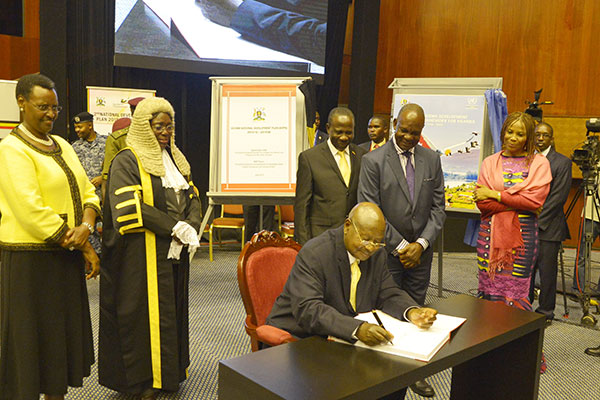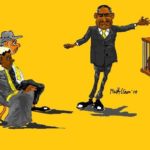
Kampala 11th June, 2015
H.E. the Vice President,
Rt. Hon. Speaker,
His Lordship, the Chief Justice,
Rt. Hon. Prime Minister,
The Hon. Alhaji Kigongo,
Ladies and gentlemen,
You have all heard the speech of the Minister of Finance. The NRM, over the last 29 years, has laid a basis for the metamorphosis of the economy and society of Uganda from a Third World one to a First World one in the coming years, the various obstacles notwithstanding. Some of the obstacles are conceptual ─ failure to prioritize, for instance. Other obstacles are moral ─ corruption of actors such as public servants or political leaders failing to supervise and discipline the civil servants. Other obstacles were historical ─ e.g. low levels of education, under-developed infrastructure, a narrow internal market occasioned by the colonial fragmentation of Africa. The NRM has, patiently, worked on all these bottlenecks.
Working with our brothers in Africa, we have revived the East African Community (EAC) and created the Common Market for Eastern and Southern Africa (COMESA). This solves the problem of the market to some extent and enables us to negotiate more credibly for access to the foreign markets. Apart from the security challenges in the region that keep popping up (Eastern Congo, South Sudan, Somalia, CAR, etc.), the producers in Uganda and the region are now assured of the markets ─ regional and international.
The NRM has addressed the issue of the human resource development ─ education and health. The literacy rate was 43% in 1986. It has now gone up to 75% today. The mortality rate for infants in 1986 was 156 per 1,000 babies born alive. It is now 54 per 1,000 babies born alive. The average life expectancy was 43 years in 1986. It is now 58 years, today. The percentage of the people living below the poverty line was 56.4% in 1992/1993. This reduced to 19.7% in 2012/2013 (Statistics from the Uganda Bureau of Statistics). We could have achieved more if we were to fight corruption and my efforts in prioritizing expenditure were to get more support.
I want to salute the NRM Caucus and other positive leaders for supporting some of my prioritization measures since 2006 ─ the Conference we had in Statistics House. Since that time, as I pointed out in my State of the Nation Address, we have spent and we are planning to spend quite abit of our money on electricity generation, electricity transmission, the roads and scientific innovation in addition to all the other expenditures on the other sectors. This has had a marked impact on these sectors ─ electricity and roads ─ that form the base of the economy. When Ugandans are able to travel on a tarmac road from Oraba-Karuma-Kampala-Mbarara-Kabale to Kyanika/ Bunagana, a distance of 1,057 kms; then, from Oraba-Karuma-Kampala-Mbarara to Murongo bridge, a distance of 906 kms, respectively and from Malaba-Kampala-Fort-Portal-Lamia River a distance of 630 kms; Malaba-Kampala -Fort Portal to Mpondwe, a distance of 517kms respectively, I feel very pleased. Soon, Ugandans will be able to drive on a tarmac road from Nimule up to Kampala and from Moroto up to Kampala.
Concerning the electricity, as I pointed out in my State of the Nation Address the other day, with the completion of Karuma and Isimba, as well as the dozens of the mini-hydros, the geo-thermal, the planned thermal and co-generation efforts, our generation capacity will go from the present 840mgws to 1,974mgws by 2020. In the medium term, with the addition of Ayago, Kiba, Uhuru, etc. power stations, our generation will stand at 4,356mgws by 2035. That is still not enough for a modern economy but we will have moved a long way from our starting point of 60 mgws in 1986.
You all know of our plans with the railway. We have signed appropriate Memoranda of Understanding (MOUs) with the Chinese Company, CHEC, to design and build a Standard Gauge Railway from Malaba to Kampala, from Tororo to Nimule-Pakwach and from Kampala to Mpondwe and Mirama Hill on the Congo and Rwanda borders. Some of the roads are done with external support e.g. Arua-Oraba and Gulu-Atiak-Nimule. I salute the Partners who thus, assist us. These include the World Bank, the EU, the African Development Bank (ADB), the British Trade Mark, the Islamic Development Bank, etc., etc.
The economy of Uganda has, in the past 29 years grown at the rate of 6.6% per annum in spite of the electricity, road, rail, ICT backbone bottlenecks. After these bottlenecks are solved, the way we are solving them, the economy will grow at the rate of 7-10% per annum. This higher rate of growth will start in the year 2020. This takes into account efficiency improvements in infrastructure spending and coming on stream of oil production. However, even at the present rate of growth, Uganda will become a lower middle-income country by 2020 ─ i.e. in the next four years. That is when, Uganda will attain a GDP per capita of US$1,039. We are, at present, at US$788 per capita (2013/14) up from US$ 665 (2009/10) an increase of 18.5%. We could have achieved more if, for instance, we had spent less on wages and spent more on infrastructure. Out of our total Budget of Ug. Shs. 23,972 trillions, 2,894 (12%) trillions is spent on the Government Wage Bill. From our own Domestic Revenue of Ug. Shs. 11,333 trillion, wages would account for 26%. By even saving a quarter of this we would be able to build one and half tarmac roads of the Kampala-Masaka type per annum, where we spent Shs. 440 billion, in addition to whatever we are doing now.
Anyway, our Baganda people say: “Ekitatta Muhima, tekimumalako e’nte” ─ “As long as a Muhima has life, he will always have cattle even if some of those cattle died in big numbers; this is on account of his dedication”. Therefore, some disorientation, notwithstanding, the NRM is set to achieve its strategic goal of modernizing Uganda.
One area we are going to address, as I pointed out in my State of the Nation Address recently, is the area of value addition and manufacturing so that we earn more forex earnings.
As you heard the Minister of Finance saying, our GDP is now Ug. Shs. 75 trillions. If the exchange rate was at Shs. 2000, our GDP size in dollars would be USD38 billion. However, on account of a weakening shilling, the size of GDP in dollars, as you heard the Minister reading, is US$ 25 billion. By adding value to our raw-materials, our GDP in dollars will rapidly grow. If we use the other method of calculating GDP, the Purchasing Power Parity (PPP) method, the GDP of Uganda today is US$ 54 billion. Industrialization and value addition are, therefore, a must. Some people misunderstand the chain of production. When we say that we are spending about Shs. 500 billion on agriculture, some people think that this is not enough. However, when we spend Ug. Shs. 3,000 billion on the roads, that money assists agriculture first and foremost. How about Defence and Security? Can you have agriculture without peace? Therefore, please, take a wholistic view of the budget and not a fragmented view.
I thank the Minister and I thank all of you.
11th June, 2015
UICC








Magnificent goods from you, man. I have have in mind your stuff prior to and you’re simply extremely wonderful. I really like what you’ve received right here, really like what you are stating and the way in which wherein you say it. You’re making it enjoyable and you still care for to stay it sensible. I cant wait to read far more from you. This is really a tremendous site.